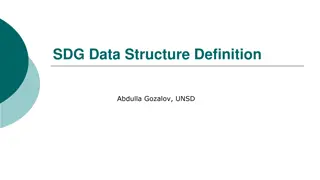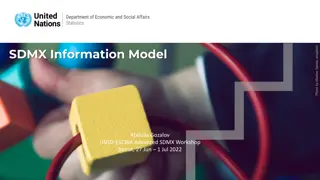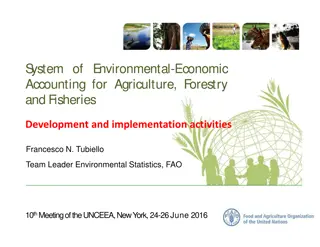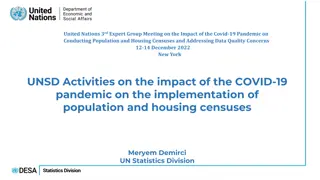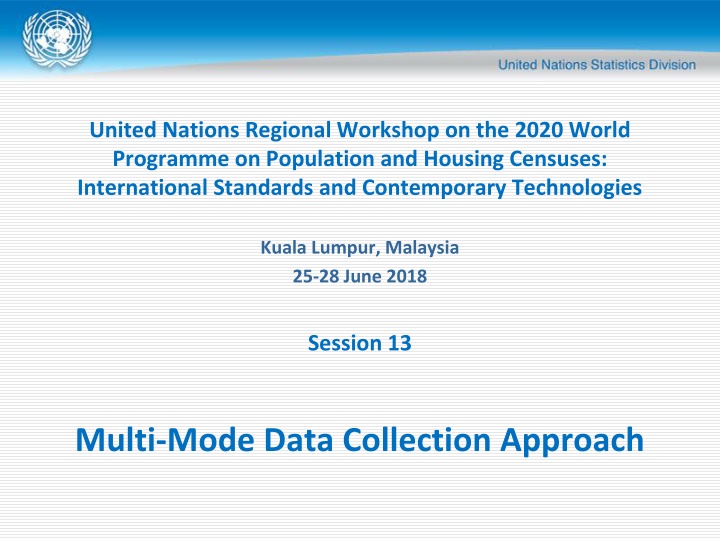
Implementing Multi-Mode Data Collection for Population Censuses
Explore the diverse modes of census data collection, design approaches for multi-mode implementation, and the benefits and challenges involved. Learn how to optimize responses through a combination of interview-administered and self-administered methods.
Download Presentation

Please find below an Image/Link to download the presentation.
The content on the website is provided AS IS for your information and personal use only. It may not be sold, licensed, or shared on other websites without obtaining consent from the author. If you encounter any issues during the download, it is possible that the publisher has removed the file from their server.
You are allowed to download the files provided on this website for personal or commercial use, subject to the condition that they are used lawfully. All files are the property of their respective owners.
The content on the website is provided AS IS for your information and personal use only. It may not be sold, licensed, or shared on other websites without obtaining consent from the author.
E N D
Presentation Transcript
United Nations Regional Workshop on the 2020 World Programme on Population and Housing Censuses: International Standards and Contemporary Technologies Kuala Lumpur, Malaysia 25-28 June 2018 Session 13 Multi-Mode Data Collection Approach
Outline Modes of census data collection Characteristics of modes Design approaches Benefits of mixing modes Decision for mixing modes Challenges o Operational management o Data integration o Mode-effect
Modes of census data collection Interviewer-administered data collection PAPI (paper q w face-to-face interview) CAPI (computer-assisted personal interview) CATI (computer-assisted telephone interview) Self-administered data collection PASI (paper q w self-enumeration) o MOMB o DOPU CASI/CAWI (computer-assisted self interviewing) o Web-based electronic questionnaire (validation, skip) o Download/upload form Multi-mode: use of more than one mode of data collection
Multi-mode data collection Modes differ in characteristics (potential strengths and limitations) Ability to access to different population groups Each mode provides better/lesser access to different population groups depending on the nature and geographical location of the population of interest Administrative and resource burdens In terms of relative costs, each mode can be ranked, with face-to-face interview being the most expensive, and self-enumeration via mail or Internet offering more economical solutions Time needed Planning , designing and implementing of each mode may require more or less time (for testing, field work, etc) Response rate Each mode offers a different response rate
Design approaches for implementing multi-mode Multi-mode data collection can be designed in two ways: o Sequential approach: All respondents are first requested to provide information in one particular mode only, then are offered other modes to increase the response rate - One common practice is to start with the least expensive mode and then progress to more expensive and more persuasive modes o Concurrent approach: Respondents are offered, at the outset, the choice of one of two or more modes by which they can provide information - An example of a concurrent mixed-mode design is offering respondents the option of completing a paper questionnaire or providing information online via the Internet
Benefits of multi-mode data collection Benefits of using multi-mode approach include: o improve coverage - Especially to reach people difficult to enumerate, such as people living alone, living in buildings difficult to access - Provide an alternative to people reluctant to participate (due to concerns about privacy) o reduce respondent burden offering alternative means to respond improve data quality o Reduce data collection cost (esp. those associate with field work) Mixing modes could potentially minimize the cost and quality issues associated with a single mode
Decision about use of multi-mode data collection Administrative and resource factors: Available budget Time period available Public acceptability and respondent burden Existing infrastructure What are additional burdens on operation? Is this approach cost-effective ? CAPI CASI Design factors: Sequential or concurrent approach What is the optimal mix of modes? CATI Ability to access different population groups, and ability to improve coverage: What geographical areas/population groups are targeted with additional mode? What is the expected proportion of population that will be enumerated with specific method? To what extent response rate will increase? Cost effectiveness? PAPI PASI
Challenges Operational management Data integration Mode-effect
Challenges - Operational management Census completeness management Operational micro-database Reliable address frame for linking households to addresses Mechanism for tracking households to avoid duplication Procedures for non-response follow up Strategy for contact& communication CAPI CASI CATI PAPI PASI
Challenges - Data integration Data from different modes Integration with Census Frame Validation during the field enumeration (non- response, missing, inconsistency) If PAPI/PASI used, data capture, coding, editing Imputation Data validation/analysis Operational micro-database Final Data
Challenges Mode effect Multi-mode data collection has implications for the quality of the collected data, particularly for data comparability Mode-effect means the bias caused by the mode of the data collection used -- due to the delivery of different results as a consequence of using different means of collection o Mode effect creates artificial differences in the population (ie. differences observed are due to how the data are collected rather than real differences in the population) o Mode effect varies depending on the type of design chosen
Challenges Mode effect Four factors impacting data quality are associated with mode- effect: Coverage, Response rate, Item non-response and Measurement differences Coverage - Coverage differs depending on the method of data collection - It is higher for face-to-face interview compared to self-enumeration methods (constrained by infrastructure: postal, telecommunication) - Coverage errors made during listing of household members could easily be resolved thru follow-up questions during a face-to-face interview, while such possibility does not exist for self-respondent who may misinterpret census questions or instructions
Challenges Mode effect Response rate: Response rates may vary with mode of contact and mode of data collection - Face-to-face interviews are more effective at securing high levels of participation, with a generally equal cooperation rate across different population groups, compared to the other modes (telephone interviews and self-response via postal mail or Internet) - Modes of data collection are more or less likely to encourage different members of the population to participate
Challenges Mode effect Item non-response: Item non-response varies with mode of data collection - It is widely recognised that the use of electronic data collection will reduce significantly item non-response compared to paper- based data collection, due to the automatic control of non- response and consistency checks during questionnaire completion - Item non-response rate tends to be lower with the use of electronic data collection modes including self- response via Internet, face-to-face interview with hand-held devices and telephone interview, compared to paper-based data collection methods
Challenges Mode effect Measurement differences o One of the major challenges of mixed-mode data collection is the fact that people tend to give different answers to questions (especially of a sensitive nature) depending on the mode in which they are asked o The tendency of respondents to modify the true response to certain sensitive questions in order to present themselves in a more favourable light is more pronounced in interviewer-administered collection than in self- enumeration
Challenges Mode effect Minimizing mode effect on data quality o Optimize design - Sequential design - one mode is used as main data collection method supported by additional data collection method for non-response follow up Primary mode data collection should be used to its maximum potential to enumerate the majority of population - Concurrent design - the different methods are equally important and respondents are given a choice There is a risk of not using a mode to its fullest potential (for example, the potential benefit from use of validation checks in electronic questionnaires) In general, sequential design has less pronounced mode-effect as compared to concurrent design
Challenges Mode effect Minimizing mode effect on data quality o Conduct empirical studies - understanding causes of mode effects on coverage, response and measurement can provide information that can help to minimize mode-effects - This kind of experimental study can be conducted with pre- tests and pilot censuses to understand mode effects on the data quality especially on item-non-response and measurement error - Findings from such experimental studies can be used to develop editing and imputation strategies in a way of decreasing mode effect on the data quality. - Where experiments are not possible, matching studies (ie. comparing information from respondents collected from different modes) is another option to assess mode effects
Collection Response Rates - Canada 2011 Census 2016 Census Collection Rate Actual Planned Actual Census Collection rate 98.1% 98% 98.4% Internet 53.8% 65% 68.3% Paper 31.3% 20% 20.5% Self-Response 85.2% 85% 88.8% NRFU 12.9% 13% 9.7% Workload at start of NRFU 4.8 M 4.5M 3.7 M Source: MCS of August 4, 2016 occupied private dwellings Source :
THANK YOU THANK YOU

